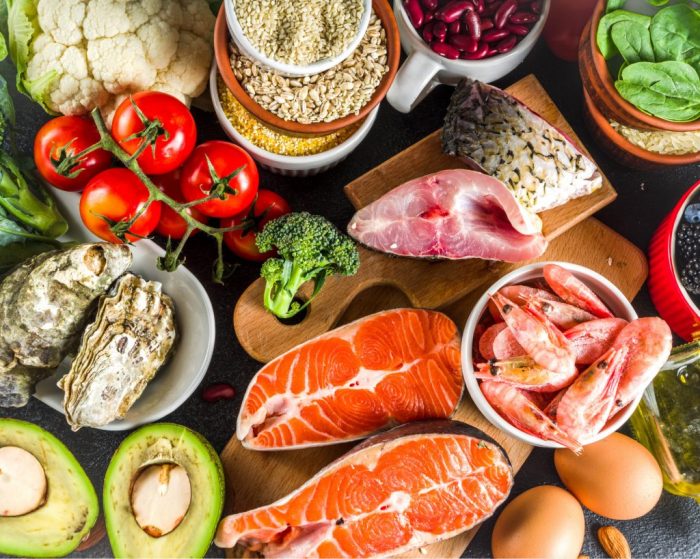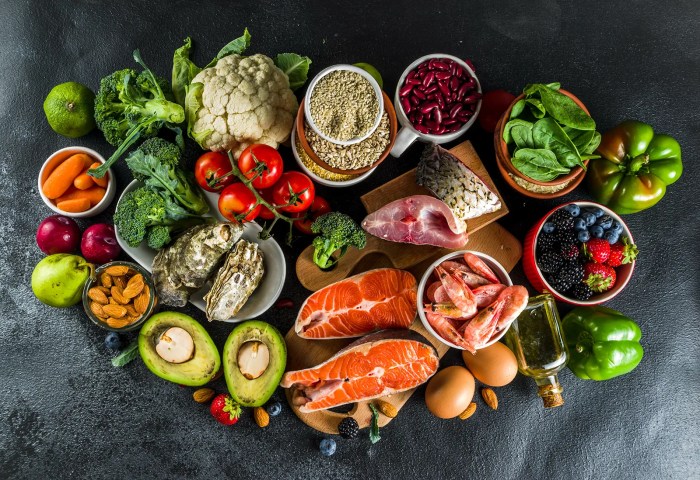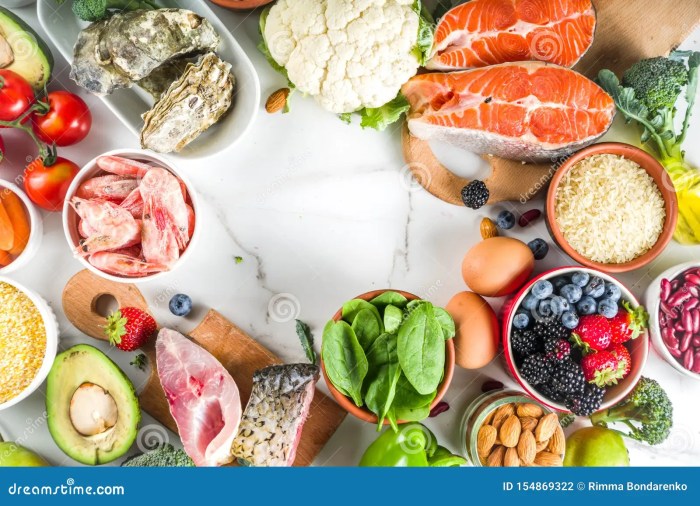What is a pescatarian diet? Dive into the world of pescatarianism, a unique dietary approach that blends the benefits of plant-based and seafood-rich eating. Explore its principles, variations, and the remarkable health advantages it offers.
Discover the different types of pescatarian diets, from lacto-ovo to vegan and flexitarian, and learn about their similarities and differences. Understand the core principles that define a pescatarian lifestyle and how it promotes a balanced and nutritious way of eating.
Definition of Pescatarian Diet
The term “pescatarian” is derived from the Italian word “pesce,” meaning “fish,” and the Latin suffix “-arian,” denoting “follower.” It refers to a dietary pattern that includes seafood (fish, shellfish, and other aquatic animals) while excluding other animal products, including meat, poultry, and eggs.
Core Principles and Characteristics
The pescatarian diet is characterized by a focus on plant-based foods, such as fruits, vegetables, whole grains, legumes, and nuts. It also includes a significant amount of seafood, which is considered a healthy source of protein, omega-3 fatty acids, and other essential nutrients.
Pescatarians typically avoid consuming meat, poultry, and eggs due to ethical concerns, environmental sustainability, or health reasons. They may choose to include dairy products and eggs in their diet, depending on their individual preferences and dietary restrictions.
Types of Pescatarian Diets

Pescatarian diets vary in their level of restrictiveness and the types of foods included. Here are some common variations:
- Lacto-ovo pescatarian:This is the most common type of pescatarian diet and includes fish, seafood, dairy products, and eggs. Lacto-ovo pescatarians do not eat meat, poultry, or other animal products.
- Vegan pescatarian:This diet is similar to a lacto-ovo pescatarian diet, but it excludes all animal products, including dairy products, eggs, and honey. Vegan pescatarians eat only plant-based foods, fish, and seafood.
- Flexitarian pescatarian:This diet is less restrictive than a lacto-ovo or vegan pescatarian diet. Flexitarian pescatarians primarily eat fish and seafood, but they occasionally eat meat or poultry. They may also eat dairy products and eggs.
All types of pescatarian diets offer potential health benefits, including reduced risk of heart disease, stroke, and certain types of cancer. However, it’s important to note that vegan pescatarians may need to take supplements to ensure they are getting enough vitamin B12, which is found only in animal products.
Health Benefits of a Pescatarian Diet
A pescatarian diet, which includes fish and seafood but excludes other types of meat, offers various health benefits. The consumption of fish and seafood provides essential nutrients and compounds that contribute to overall well-being.
Research suggests that a pescatarian diet may:
- Reduce the risk of heart disease:Fish and seafood are rich in omega-3 fatty acids, which have anti-inflammatory properties and may help lower blood pressure, reduce triglycerides, and improve cholesterol levels.
- Protect against certain types of cancer:Studies have shown that fish consumption may be associated with a reduced risk of certain types of cancer, including prostate, colon, and breast cancer. This is attributed to the presence of omega-3 fatty acids, antioxidants, and other protective compounds in fish.
- Support brain health:Omega-3 fatty acids are essential for brain development and function. Consuming fish and seafood regularly may help improve cognitive function, reduce the risk of dementia, and protect against age-related cognitive decline.
- Promote bone health:Fish and seafood are good sources of vitamin D, which is crucial for bone health. Vitamin D helps the body absorb calcium, which is essential for maintaining strong and healthy bones.
- Improve mental health:Omega-3 fatty acids have been shown to have positive effects on mental health. They may help reduce symptoms of depression and anxiety, improve mood, and promote overall well-being.
Food Sources in a Pescatarian Diet
A pescatarian diet emphasizes the consumption of fish and seafood while excluding other types of meat. This dietary approach also includes a variety of plant-based foods, such as fruits, vegetables, legumes, and whole grains.
Fish and Seafood, What is a pescatarian diet
* Salmon
- Tuna
- Cod
- Shrimp
- Oysters
- Mussels
- Clams
- Squid
- Octopus
Plant-Based Foods
* Fruits: Apples, bananas, oranges, berries, avocados
Vegetables
Pescatarianism is becoming increasingly popular as people seek healthier and more sustainable dietary choices. While it can sometimes be perceived as an expensive lifestyle, there are plenty of budget-friendly pescatarian recipes available. From budget-friendly pescatarian recipes to meal planning tips, there are ways to enjoy a pescatarian diet without breaking the bank.
Leafy greens, broccoli, carrots, onions, tomatoes
Legumes
Beans, lentils, chickpeas
Whole grains
Brown rice, quinoa, oats, whole-wheat bread
Embark on a culinary journey with pescatarian recipes on a budget that won’t break the bank. These delicious and nutritious meals cater to those seeking a plant-based and seafood-centric diet, all while keeping your wallet happy. From tantalizing tacos to hearty soups, discover the endless possibilities of pescatarian cooking without sacrificing flavor or affordability.
Dairy and Eggs (Optional)
* Milk
- Yogurt
- Cheese
- Eggs
Meal Planning for a Pescatarian Diet

Meal planning for a pescatarian diet is straightforward and allows for plenty of variety. By incorporating a diverse range of seafood, fruits, vegetables, whole grains, and healthy fats, you can create balanced and satisfying meals.
Here’s a sample meal plan to get you started:
Breakfast
- Oatmeal with berries, nuts, and a drizzle of honey
- Yogurt with fruit and granola
- Scrambled eggs with smoked salmon and whole-wheat toast
Lunch
- Grilled salmon salad with mixed greens, quinoa, and vegetables
- Tuna sandwich on whole-wheat bread with avocado and sprouts
- Lentil soup with a side of brown rice
Dinner
- Baked cod with roasted vegetables and quinoa
- Grilled shrimp tacos with corn tortillas and salsa
- Pasta with marinara sauce and sautéed vegetables
Snacks
- Fruit (apple, banana, berries)
- Vegetables (carrots, celery, cucumbers)
- Trail mix with nuts, seeds, and dried fruit
Considerations and Challenges of a Pescatarian Diet
Adopting a pescatarian diet, while offering many potential health benefits, also comes with certain considerations and challenges. These include concerns about nutrient deficiencies, sustainability, and social factors. Understanding these challenges can help you navigate a pescatarian lifestyle successfully.
Nutrient Deficiencies
A pescatarian diet may be low in certain nutrients, such as vitamin B12, iron, and omega-3 fatty acids. Vitamin B12 is found primarily in animal products, and while fish provides some B12, it may not be sufficient to meet daily requirements.
Iron is also essential, and although fish is a good source of heme iron, non-heme iron from plant sources is less well-absorbed. Omega-3 fatty acids are abundant in fatty fish, but vegetarians and vegans may need to supplement with algae-based sources.
Sustainability Concerns
Overfishing and unsustainable fishing practices pose challenges to the sustainability of a pescatarian diet. Some fish species are threatened due to overfishing, and choosing sustainable seafood options is crucial. Look for fish that are certified by organizations like the Marine Stewardship Council (MSC) or the Aquaculture Stewardship Council (ASC).
Social Factors
Social gatherings and dining out can present challenges for pescatarians. Many traditional dishes and restaurant menus may not cater to pescatarian preferences. It is essential to communicate your dietary choices clearly and be prepared to ask for modifications or explore restaurants with pescatarian-friendly options.
Last Recap: What Is A Pescatarian Diet

In conclusion, a pescatarian diet offers a well-rounded approach to healthy eating, providing a rich source of essential nutrients while promoting sustainability and environmental consciousness. Whether you’re seeking to improve your overall well-being, reduce your environmental impact, or simply explore new culinary adventures, a pescatarian diet may be the perfect choice for you.
Helpful Answers
What are the key principles of a pescatarian diet?
A pescatarian diet emphasizes plant-based foods while including fish and other seafood in moderation. It excludes meat, poultry, and animal products like dairy and eggs.
What are the different types of pescatarian diets?
There are various types of pescatarian diets, including lacto-ovo pescatarian (includes dairy and eggs), vegan pescatarian (excludes all animal products), and flexitarian pescatarian (allows occasional meat or poultry consumption).
What are the potential health benefits of a pescatarian diet?
A pescatarian diet has been associated with a reduced risk of heart disease, stroke, type 2 diabetes, and certain types of cancer. It also promotes brain health and may improve overall well-being.